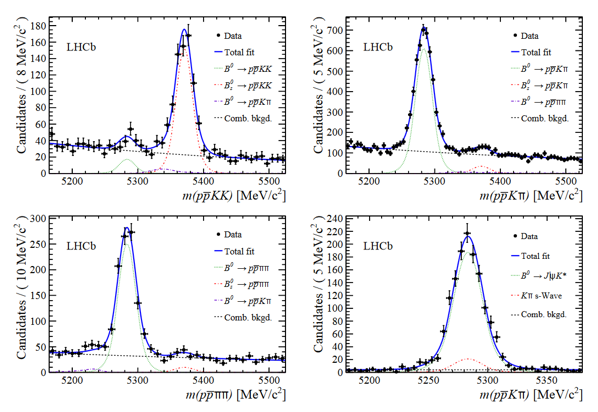The LHCb collaboration presented several new results at the 31st Rencontres de Physique de la Vallée d’Aoste taking place this week in La Thuile, Italy. A few selected items are listed below.
Processes where a B meson decays into a pair of oppositely charged leptons are powerful probes in the search for physics beyond the Standard Model. Following up the preliminary result that was presented recently at a CERN seminar on the first observation by a single experiment of the decay Bs0→ μ+μ–, with a statistical significance of 7.8 standard deviations, the final result was shown at La Thuile for the first time. This presentation provoked much interesting discussion. A search for the tauonic decays B→τ+τ–, where B can be either a B0 or a Bs0 meson, was also shown in La Thuile. The τ leptons are reconstructed in the analysis through the decay τ→π–π+π–ντ. Decays of B0 and Bs0 mesons into τ+τ– pairs have not yet been observed, but the LHCb analysis yields the first direct limit on the Bs0 branching fraction as well as the world’s best limit on the B0 branching fraction.

The first observation of the four-body charmless baryonic decays Bs0→ppK+K–, Bs0→ppK±π∓ and B0→ppπ+π– was reported as well as the evidence for the B0→ppK+K– decay, see images above. These decays are of great interest in the search for further manifestations of CP violation in baryonic B decays, see the first evidence for the violation of the CP symmetry in baryon decays.
All of these results have been obtained owing to the excellent performance of the LHC collider and LHCb detector. The physics opportunities that exist with an upgraded LHCb detector in the High Luminosity LHC era are even more impressive. A phase-1 upgrade of the experiment is currently being prepared and will be installed in the long-shutdown 2, in 2019-2020. The physics case for the so-called LHCb Phase-II upgrade, following the recent submission of an Expression of Interest by the LHCb collaboration, was also presented for the first time in public.
More details can be found in LHCb presentations at La Thuile: 1, 2 and 3.
